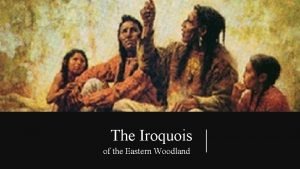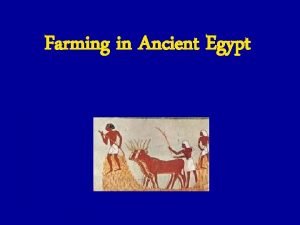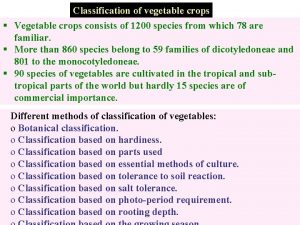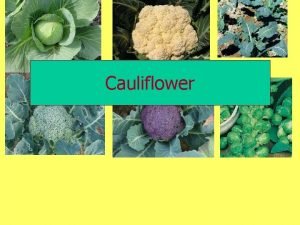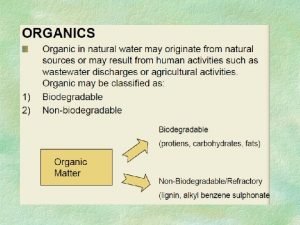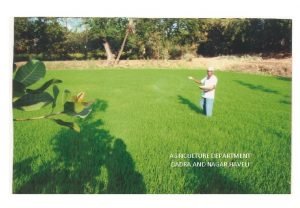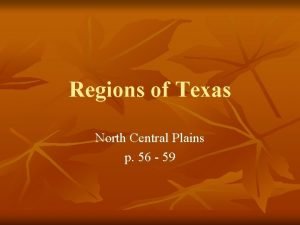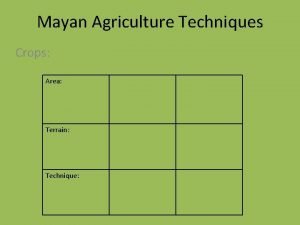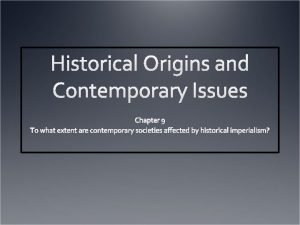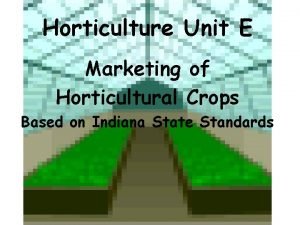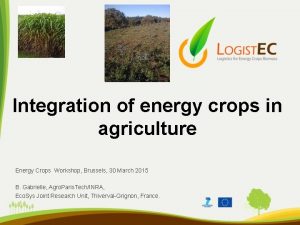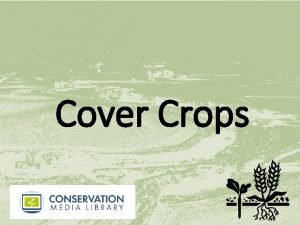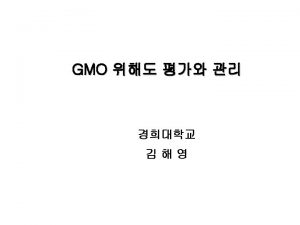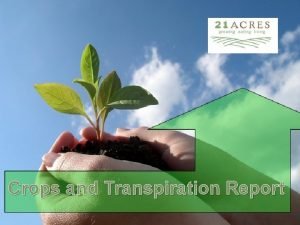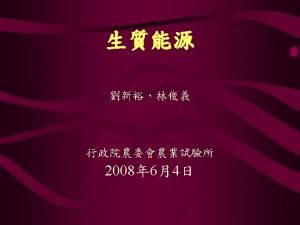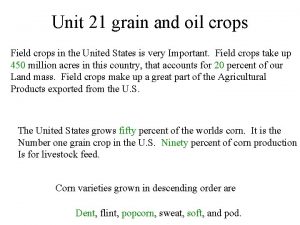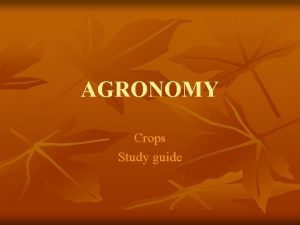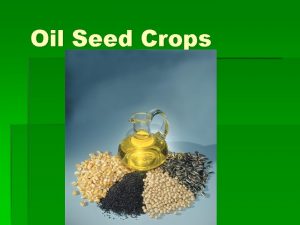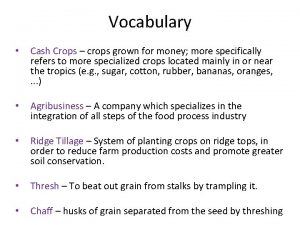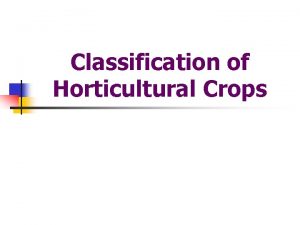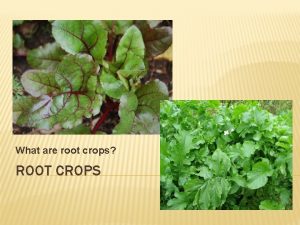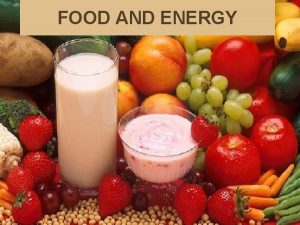Food vs Energy Crops for Energy Dr William























- Slides: 23

Food vs Energy: Crops for Energy Dr William D Dar Director General ICRISAT

Outline of Presentation • • • About ICRISAT Why Biofuels? Global scenario-Biofuels Food-fuel trade-offs Ethics Australian Scenario Pro-poor Bio. Power initiative Impact Conclusion

Vision A prosperous, food-secure and resilient dryland tropics Mission To reduce poverty, hunger, malnutrition and environmental degradation in the dryland tropics

ICRISAT Locations in the Semi-arid Tropics Headquarters WCA Regional Hub Bamako, Mali Patancheru, Telangana, India ESA Regional Hub Nairobi, Kenya 55 countries 6. 5 million sq km 2. 5 billion people

IMOD: A New Strategic Framework Inclusive Market-Oriented Development (IMOD) Harness Markets Tech-based Innovations Manage Risks

Why Biofuels? • Alternative to oil based fuels (95%) for the transport sector • Solution to global environmental concerns about climate change, energy security and reduction in oil imports – Environmentally superior fuels with lower CO 2 emissions • Potential source of income for the poor

Major Biofuel Feedstocks

US-Corn and Brazil-Sugarcane vs Food Prices Biofuel demand does affect food commodity prices Moderate effect on sugar prices (Bastianin et al 2013)

Biofuels and Land Use Change (LUC) • Direct and indirect • With present technology, 100 billion litres require 2 -3% of global arable land (OECD, 2006) • Striking differences between the percentages of cropland need be dedicated to biofuels in Brazil (3%) and the EU (72%) • Environmental benefits vis-a-vis LUC poorly understood

Ethical Principles in Biofuels Development • Should be environmentally sustainable • Should contribute to a net reduction of total greenhouse gas emissions • Should not be at the expense of people’s essential rights • Should involve women and smallholder farmers • Should adhere to fair trade principles

Australia- Energy Scenario 9 th largest energy producer 17 th largest consumer of nonrenewable energy Portfolio: 96% Non-renewables 4% renewables Renewable energy consumption is rising Biofuel/gas share: 0. 4% ONLY Bioethanol: internal consumption (440 ML) Biodiesel: Exported (10 ML out of 350 ML) (2013 Australian Energy Statistics)

Australia- Biofuel Production Facilities

Australia- Biofuel Plans • Federal: Clean Energy Future Plan - $17 billion over the next 10 years - $20 million to the Advanced Biofuels - $23 per ton carbon tax on emitting firms • New South Wales: 6% ethanol and 5% biodiesel blending mandatory • Queensland: goal to become a leader in bio-based industrial products and technology by 2020 • Queensland Alliance for Agriculture and Food Innovation (QAAFI) is working on sugarcane, eucalyptus, pongamia, sorghum • Western Australia: 13, 400 ha in the Ord river area is allocated to grain sorghum for biofuels • Pilbara region as an ideal location for algae production

ICRISAT’s Pro-poor Bio. Power Initiative • Bio. Power empowers the dryland poor to • • benefit from emerging bioenergy opportunities Ensures both food and energy security Focuses on biomass, juice and grain yields Greater smallholder incomes Sustaining environments

Sweet Sorghum: Food-Feed-Fuel

Food-Fuel Tradeoff 7 9 8 5 7 4 A challenge 3 2 1 Grain yield (t ha-1) Sugar yield (t ha-1) 6 6 5 4 3 2 1 0 0 Varieties Hybrids Rainy season Sugar yield Varieties Hybrids Postrainy season Varieties Hybrids Rainy season Varieties Hybrids Postrainy season Grain yield Rainy: Higher sugar yield, No trade-offs Post-rainy: Lower sugar yield and high grain yield, Negligible trade-off in sweet sorghum hybrids (ICRISAT sweet sorghum trials 2011 -13)

Economic Assessment • Biofuels will take off in countries where subsidies on fuel are low to medium. • Low feedstock costs are important component of over all cost of biofuels • Studies in India, China, Brazil indicate that whole plant utilization of sweet sorghum and by-products from processing leads to positive economic returns. Feed block Favourable policy environment required

Partnerships for the Poor ICRISAT, Rusni Distilleries & TCL tie-up through ABI

China- Exploring Sweet Sorghum ZTE Distillery, Inner Mangolia Crushed 25000 t of sweet sorghum in 2013 and forging ahead

Bapamin Enterprises- Philippines Pioneers in by-product utilization!

One Practical Approach in India A demo of sweet sorghum as feedstock in two sugar mill areas promising Proposed Bioenergy Calendar Sugarcane season: Nov-Mar Sugarcane harvesting Sweet sorghum planting Sweet sorghum harvesting

Conclusions Ø Food security is paramount over energy security Ø Need to balance food security and energy security to mitigate food price volatility Ø Biofuel development offers both opportunities and risks Ø Sweet sorghum is a competitive feedstock Ø Policy and R 4 D are essential Ø Smallholder participation and gender inclusiveness are key to success

YES! We can ensure food- energyenvironmental security, together! ICRISAT is a member of the CGIAR Consortium
 Pictures of food crops
Pictures of food crops Unit 2 food food food
Unit 2 food food food Food chain food chain food chain
Food chain food chain food chain Food scientists measure food energy in
Food scientists measure food energy in Why does organism eat another organism
Why does organism eat another organism Main crops in greece
Main crops in greece What type of food did the iroquois eat
What type of food did the iroquois eat Crops and their scientific names
Crops and their scientific names Horticultural maturity example
Horticultural maturity example What crops did egypt grow
What crops did egypt grow Botanical classification of vegetable
Botanical classification of vegetable Riceyness in cauliflower
Riceyness in cauliflower My crops doing well
My crops doing well Kayla antoniou
Kayla antoniou Crops
Crops Agri chemicals projects in dadra & nagar haveli
Agri chemicals projects in dadra & nagar haveli How does katniss react to peeta’s declaration of love?
How does katniss react to peeta’s declaration of love? Where is the north central plains located in texas
Where is the north central plains located in texas Mayan agriculture techniques
Mayan agriculture techniques Mexican crops
Mexican crops Marketing of horticultural crops
Marketing of horticultural crops Golden crops foe
Golden crops foe He never polishes his shoes so he never looks smart
He never polishes his shoes so he never looks smart Spatial arrangement of crops
Spatial arrangement of crops






